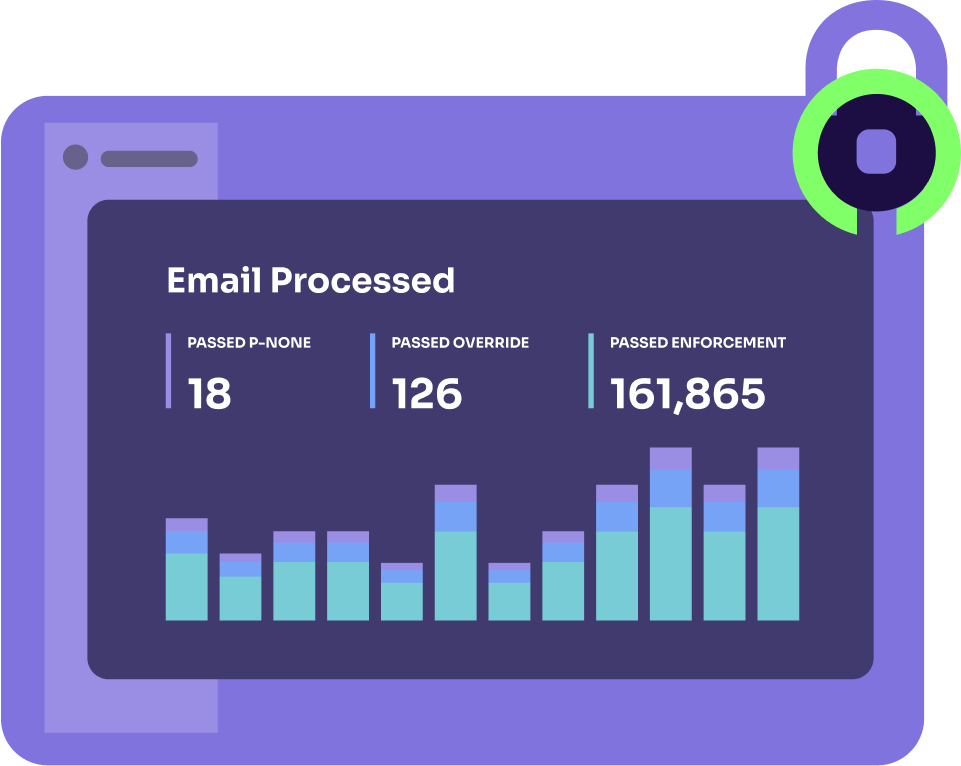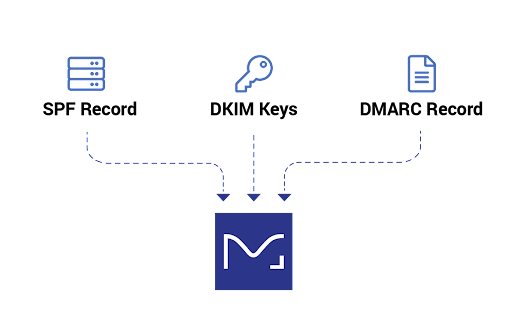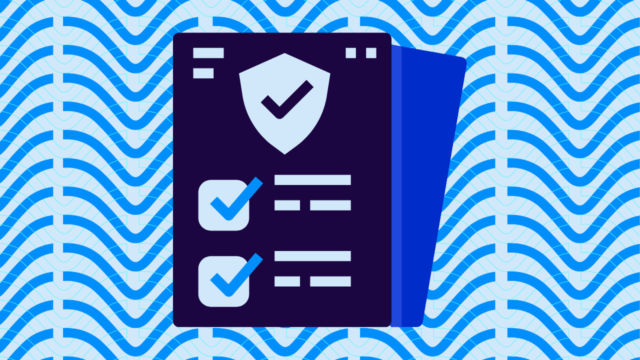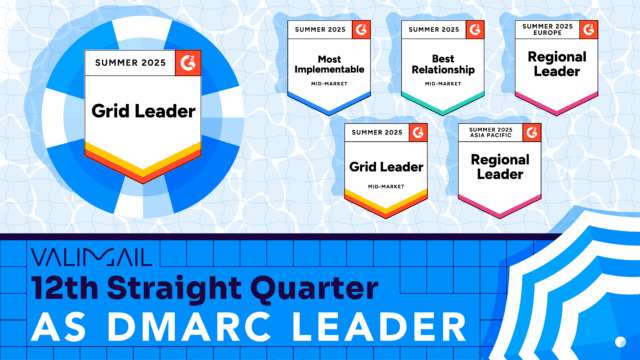While we’ve seen communication channels and platforms come and go, email remains a cornerstone of B2C and B2B communication. From marketing campaigns and customer support to transactional notifications and newsletters, email plays a pivotal role in connecting with your audience.
But your communications program is nothing without DMARC (Domain-based Message Authentication, Reporting, and Conformance) and top-notch email deliverability.
As the volume of your email communication grows, so does the challenge of landing these messages in your recipients’ inboxes. Amidst the growing pile of spam, promotional content, and malicious phishing attempts, your genuine business emails risk going unopened, landing in the spam folder, or (worst of all) not delivering to the recipient.
That’s where DMARC helps.
Consider it your email’s passport, verifying its authenticity and ensuring it reaches the inbox (where it belongs). DMARC isn’t just about email security—it’s about amplifying your voice in a crowded digital space, making sure your messages get seen and read.
Below, we’ll guide you through the relationship between DMARC and email deliverability. We’ll walk you through the tools and strategies you can use to secure your emails and elevate your delivery rates.
What is email deliverability?
Email deliverability refers to the ability of your emails to reach the intended recipient’s inbox without being blocked or flagged as spam. Factors such as your sending reputation, opt-ins, engagement, security, trustworthiness, and email content influence your deliverability.
Here’s a simple analogy: imagine sending a letter via traditional mail. You’d want that letter to reach the recipient’s mailbox, right? However, if the post office thought you were scamming people or had incorrect addresses, they might not send the letters.
In the digital realm, email deliverability ensures that your “electronic letter” lands in the recipient’s primary inbox, not their spam folder or, worse, not delivered at all.
Why email deliverability should be a priority
Email deliverability is often one of those things that you only care about once it goes wrong. However, recovering will always be more challenging than proactive steps to maintain (and improve) your deliverability rates.
Here’s why it matters so much:
- Brand Reputation: Consistent email deliverability fosters trust. If your emails consistently land in the spam folder, it can tarnish your brand’s reputation, making recipients skeptical of your communications.
- ROI on Email Campaigns: For businesses investing in email marketing, deliverability directly impacts ROI. If your emails aren’t reaching inboxes, you’re missing out on potential conversions and engagements.
- Effective Communication: Whether it’s a product update, a newsletter, or a transactional email, you want your message to be seen and acted upon. High deliverability ensures your communications achieve their intended purpose.
- Transactional Delivery: You can’t afford for your transactional emails to land in the spam folder or not get delivered at all. Your customers need confirmation emails, delivery updates, password reset emails, and more immediately.
What is DMARC?
DMARC is a powerful email authentication protocol designed to combat email fraud. It guarantees that your emails are genuine and haven’t been tampered with during transit.
Here’s a quick breakdown:
- Authentication: DMARC works with two other email authentication methods, DKIM (DomainKeys Identified Mail) and SPF (Sender Policy Framework). While DKIM provides a digital signature to verify an email’s source and integrity, SPF ensures the email originates from an approved server. DMARC uses the results from these methods to authenticate the email.
- Policy Enforcement: As a sender, you can define a DMARC policy, instructing email servers how to handle unauthenticated emails. You can choose to let them through, quarantine them (like sending them to spam), or reject them outright.

- Reporting: One of DMARC’s standout features is its feedback mechanism. Email servers send reports back to the domain owner, detailing which emails passed or failed DMARC checks. This provides invaluable insights, allowing you to refine your email strategy and improve deliverability.
Does DMARC improve email deliverability?
Yes, it does.
DMARC and email deliverability are directly related. We’ve found brands can see up to a 10% boost in email deliverability after successfully reaching DMARC enforcement.
But to understand how let’s first look at the challenges of email deliverability in today’s digital landscape:
- Rising Email Fraud: With the surge in cyber threats, email fraud, especially phishing and spoofing, has become rampant. These malicious activities deceive recipients and tarnish the reputation of legitimate brands whose domains are misused.
- Stringent ISP Filters: Internet Service Providers (ISPs) have implemented strict filtering mechanisms to combat the rising threats. While these filters protect users, they can sometimes be overzealous, flagging genuine emails as spam.
- Eroding Trust: Due to the prevalence of email-based threats, recipients have become wary of emails, especially those from unfamiliar sources. This skepticism can lead to lower open rates and engagement.
- Complex Email Ecosystem: With businesses using multiple third-party tools and services for email campaigns, ensuring consistent deliverability across all platforms can be challenging.
Enter DMARC. Positioned at the intersection of security and deliverability, DMARC offers a solution to these challenges, ensuring that genuine emails from verified domains reach their intended recipients.
By vouching for the authenticity of emails, DMARC rebuilds trust, enhances brand reputation, and guarantees that your messages stand out in a crowded inbox.
How DMARC improves your email deliverability
Let’s get into the nitty-gritty of how DMARC improves your email deliverability:
1. Boosted trust with ISPs
DMARC acts as a seal of authenticity, signaling to ISPs that your emails are genuine and should be trusted. When ISPs trust your emails, they’re more likely to deliver them directly to the recipient’s primary inbox.
2. Protection from spoofing and phishing
DMARC’s primary goal is to prevent unauthorized use of your domain. Doing so ensures that malicious actors can’t tarnish your brand’s reputation by sending fraudulent emails from your domain.
And a good reputation leads to better deliverability.
3. Feedback and continuous improvement
The reporting feature of DMARC provides insights into which emails are failing authentication checks. This feedback allows you to identify and rectify issues to authenticate and deliver more emails.
4. Enhanced brand recognition
When DMARC is implemented at its strictest policy, it paves the way for BIMI (Brand Indicators for Message Identification).
BIMI allows your brand’s logo to be displayed next to the email in the recipient’s inbox, further establishing trust and increasing the likelihood of your email being opened.

5. Reduced false positives
With DMARC in place, genuine emails from your domain are less likely to be mistakenly flagged as spam by ISP filters, ensuring they reach the primary inbox.
6. Improved engagement metrics
Emails that land in the primary inbox have higher open and click-through rates. DMARC, by improving deliverability, indirectly boosts these engagement metrics. And when these engagement metrics improve, so does your deliverability—it’s a win-win cycle for your communications.
7. Global reach
DMARC is recognized and respected globally. Implementing DMARC provides consistent email deliverability across different regions and ISPs.
8. Future-proofing
As cyber threats evolve, DMARC continues to be updated and refined. Implementing DMARC guarantees that your email deliverability strategy is future-ready and adaptable to emerging challenges.
Steps to implement DMARC for better deliverability
Ready to implement DMARC for your brand? There are two ways to go about this process:
- Manual Implementation
- Valimail Enforce
Manual implementation
- Assess Current Email Landscape: Before implementing DMARC, take stock of all the services and tools that send emails on behalf of your domain. This includes marketing platforms, CRM systems, support desks, and more.
- Set Up SPF and DKIM: DMARC relies on SPF and DKIM for email authentication. Make sure both are correctly set up for your domain.
- Create a DMARC Record: Craft a DMARC record in your domain’s DNS settings. This record will define your DMARC policy, specifying how you want unauthenticated emails to be handled (e.g., none, quarantine, or reject).
- Start with a Monitoring Policy: Initially, set your DMARC policy to “none.” This allows you to monitor authentication results without affecting email deliverability.
- Analyze Reports: ISPs will send DMARC reports to the specified email address in your DMARC record. Regularly review these reports to understand authentication successes and failures.
- Refine and Enforce: Once you’re confident in the authentication results, gradually tighten your DMARC policy. Move from “none” to “quarantine” and eventually to “reject” to ensure only authenticated emails are delivered.
- Monitor and Update: Keep an eye on your DMARC reports and monitor deliverability. Whenever your business adds new domains or makes changes, update your DMARC, SPF, and DKIM records.
Valimail Enforce

Implementing DMARC manually can be intricate and time-consuming. Valimail offers a more streamlined and efficient approach:
- Automated Inventory: Valimail automatically identifies all services and tools sending emails on your behalf, ensuring no sender is overlooked.
- One-Click Authentication: With Valimail’s intuitive platform, setting up SPF, DKIM, and DMARC becomes a breeze—no need to delve into complex DNS settings.
- Real-time Monitoring: Valimail provides real-time insights into your email authentication performance, translating raw DMARC reports into actionable feedback.
- Guided Policy Enforcement: Valimail guides you through the DMARC enforcement process to help you move to stricter policies with confidence.
- Continuous Compliance: As your business evolves, Valimail keeps your DMARC, SPF, and DKIM records up-to-date, maintaining optimal email deliverability.

Get started with DMARC enforcement
Understanding DMARC and implementing it effectively can be a daunting task. We get it, and that’s where Valimail steps in to help. Whether you’re just starting your journey into the world of email authentication or looking to enforce a stringent DMARC policy, Valimail has the tools and expertise to guide you.
- For Starters: Dip your toes into the world of DMARC with Valimail Monitor. It’s free and offers real-time insights into your email authentication performance, helping you understand the landscape and prepare for stricter enforcement.
- For the Proactive: Ready to take the leap and enforce DMARC? Valimail Enforce is your trusted companion. With its intuitive platform and automated features, DMARC enforcement becomes a seamless process to securing optimal email deliverability and fortifying your brand’s reputation.
In today’s digital landscape, DMARC isn’t a recommendation—it’s a necessity.
With Valimail on your team, the journey to optimal email deliverability becomes smoother and more efficient. Don’t let your emails get lost. Embrace DMARC, fortify your brand’s digital presence, and communicate with confidence and authenticity.



